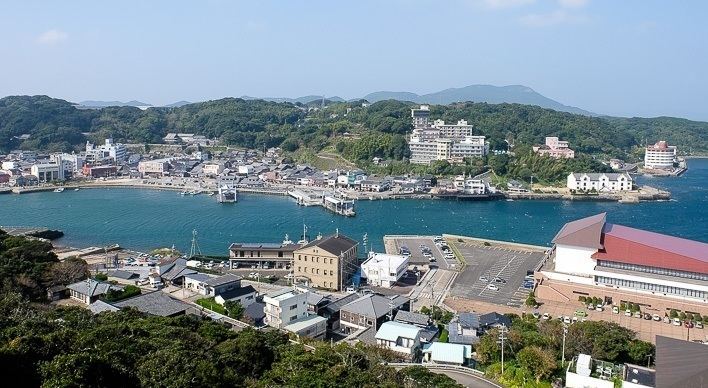Population 36,000 (1 Jan 2009) | Area 235.6 km² | |
 | ||
Time zone Japan Standard Time (UTC+9) Website www.city.hirado.nagasaki.jp/english Weather 13°C, Wind NE at 11 km/h, 50% Humidity Points of interest Hirado Castle, Tabira Catholic Church, Kōmyō‑ji Temple, Kameoka Shrine, Kawachi Touge Pass | ||
Celebration day for the birthday of koxinga hirado nagasaki 2010 07 14 2
Hirado (平戸市, Hirado-shi) is a city located in Nagasaki Prefecture, Japan. The part historically named Hirado is located on the island of the same name. With recent mergers, the city's boundaries have expanded, and Hirado now occupies parts of the main island of Kyushu. The components are connected by the Hirado Bridge.
Contents
- Celebration day for the birthday of koxinga hirado nagasaki 2010 07 14 2
- Map of Hirado Nagasaki Prefecture Japan
- Celebration day for the birthday of koxinga hirado nagasaki 2010 07 14 1
- History
- Climate
- Notable residents
- Twin towns Sister cities
- References
Map of Hirado, Nagasaki Prefecture, Japan
As of January 1, 2009, the city has an estimated population of 36,000 and a population density of 153 persons per km². The total area is 235.63 km2 (91 square miles).
Celebration day for the birthday of koxinga hirado nagasaki 2010 07 14 1
History
Hirado has been a port of call for ships between the Asian mainland and Japan since the Nara period. During the Kamakura and Muromachi periods, the local Matsuura clan held the rights to trade with Korea and with Song-dynasty China. During the Sengoku and early Edo periods, Hirado's role as a center of foreign trade increased, especially vis-à-vis Ming-dynasty China and the Dutch East India Company (Vereenigde Oost-Indische Compagnie or VOC). The Portuguese arrived in 1550; and the English and Dutch initially reached Japan at the beginning of the 17th century.
The first step in the profitable Dutch-Japanese trading relationship was the Shogun's grant of a trading pass (handelspas) in 1609.
At its maximum extent, the Dutch trading center covered the whole area of present-day Sakikata Park. In 1637 and in 1639, stone warehouses were constructed, and the Dutch builders incorporated these dates into the stonework. However, the Tokugawa shogunate disapproved of the use of any Christian Era year dates, and therefore demanded the immediate destruction of these two structures. This failure to comply with strict sakoku practices was then used as one of the Shogunate's rationales for forcing the Dutch traders to abandon Hirado for the more constricting confines of Dejima, a small artificial island in the present-day city of Nagasaki. The last VOC Opperhoofd or Kapitan at Hirado and the first one at Dejima was François Caron, who oversaw the transfer in 1641. However, modern research indicated that this incident might actually have been an excuse for the Shogunate to take the Dutch trade away from the Hirado clan. The stone warehouse from 1639 that was torn down was reconstructed back to its original form in 2011.
During the Edo period, Hirado was the seat of the Hirado Domain. Hirado Castle is today an historical and architectural landmark.
The island was the namesake of IJN cruiser Hirado.
The modern city was founded on January 1, 1955. The city expanded by merging on October 1, 2005, with the neighboring towns of Tabira, Ikitsuki, and the village of Ōshima. The local economy is dominated by agriculture, fishing and food processing.
Climate
Hirado has a humid subtropical climate (Köppen climate classification Cfa) with very warm summers and cool winters. Precipitation is significant throughout the year, but is much higher in the summer.
Notable residents
Twin towns – Sister cities
Hirado has one sister city in Japan and one sister city and one friendship city outside Japan.
